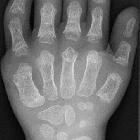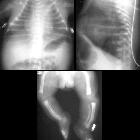skeletal dysplasia
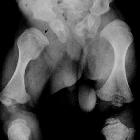



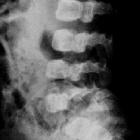





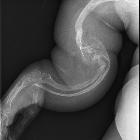











Skeletal dysplasia (also known as osteochondrodysplasia) refers to any abnormality in bone formation. There is a very wide clinicopathological spectrum and any part of the skeleton can be affected.
Epidemiology
The overall prevalence is estimated at ~2 per 10,000 live births .
Pathology
Types
At least 32 groups with more than 350 distinct entities have been described . One way of broadly classifying them is into limb deficiency, limb shortening/dysplastic or non-limb shortening types. Another way of categorizing is by whether the dysplasia is sclerosing or non-sclerosing.
Limb deficiencies
- amelia: complete limb absence
- meromelia: partial limb absence
Limb shortening/dysplastic
See: short limb skeletal dysplasias
Rhizomelic dwarfism
Rhizomelic dwarfism is characterized by limb shortening, being most notable proximally:
- achondroplasia (most common short-limbed dwarfism)
- thanatophoric dysplasia
- osteogenesis imperfecta
- rhizomelic chondrodysplasia punctata
- asphyxiating thoracic dysplasia (Jeune disease)
- atelosteogenesis
Non-rhizomelic dwarfism
- non-rhizomelic chondrodysplasia punctata: Conradi-Hunermann syndrome
- diastrophic dysplasia
- campomelic dysplasia
- chondroectodermal dysplasia / Ellis-van Creveld syndrome
- Kniest dysplasia
- achondrogenesis
- type I
- type Ia: Houston-Harris subtype
- type Ib: Parenti-Fraccaro subtype
- type II: Langer-Saldino syndrome
- type I
- spondyloepiphyseal dysplasia
- multiple epiphyseal dysplasia: mild limb shortening
- hypochondroplasia
- metaphyseal chondrodysplasia
- Schmid type
- Pena and Vaandrager type
- Jansen type
- McKusick type
Non-limb shortening
- Pyle disease: metaphyseal dysplasia
- progressive diaphyseal dysplasia: Camurati-Engelmann disease
- more to be added
Radiographic features
Skeletal dysplasias are usually diagnosed on antenatal ultrasound or after birth on the basis of clinical features and radiography. There are a wide variety of radiographic features and these are discussed separately.
Antenatal ultrasound
Although no single unifying features exist, Mahony has proposed an evaluation of the following sonographic parameters and questions, which are helpful to achieve a precise diagnosis:
- what is the degree of bone shortening?
- the severity of bone shortening varies from extreme (many standard deviations below the mean, at least 5-6 weeks below expected length for gestational age, with the limbs oriented at approximately right angles to the fetal trunk) to mild-to-moderate (with a more normal orientation of the limbs to the fetal trunk)
- what is the distribution of involvement?
- rhizomelic, mesomelic, or acromelic bone shortening occurs with different dysplasias
- are bone fractures or extremity bowing present?
- fractures usually indicate osteogenesis imperfecta
- extremity bowing may indicate the presence of a fracture, campomelic dysplasia, or diastrophic dysplasia
- thanatophoric dysplasia may produce a "telephone receiver" appearance of the femurs
- what is the degree and distribution of ossification?
- diffuse hypomineralization usually indicates osteogenesis imperfecta or hypophosphatasia
- focal hypomineralization of the spine indicates achondrogenesis
- what is the calvarial configuration?
- cloverleaf skull deformity with micromelia indicates thanatophoric dysplasia
- what is the thoracic size?
- a small thorax indicates a high probability of pulmonary hypoplasia, but the thoracic shape often does not assist in rendering a specific diagnosis
- rib fractures with a bell-shaped thorax usually indicates osteogenesis imperfecta
- is polydactyly present?
- polydactyly with skeletal dysplasia usually indicates short rib polydactyly syndrome, chondrodysplasia punctata, or asphyxiating thoracic dysplasia
Treatment and prognosis
The prognosis is widely variable, ranging from being lethal to very mild cosmetic deficits.
See also
Siehe auch:
- Osteogenesis imperfecta
- Achondroplasie
- Rhizomelie
- Chondrodysplasia punctata
- asphyxierende Thoraxdysplasie (Jeune-Syndrom)
- Diastrophische Dysplasie
- Thanatophore Dysplasie
- Ellis-van-Creveld-Syndrom
- camptomelic dysplasia
- chondroectodermal dysplasia
- short limb skeletal dysplasias
- Kniest-Syndrom
- Camurati-Engelmann-Syndrom
- Pyle-Syndrom
- lethal skeletal dysplasias
- Achondrogenesie
- Atelosteogenesis
- Osteoglophone Dysplasie
- sclerosing
und weiter:
- Skoliose
- Polydaktylie
- Kleidokraniale Dysplasie
- nuchal translucency
- Klumpfuß
- short limb skeletal dysplasia
- intraspinale zystische Läsionen
- Kniest-Dysplasie
- Intrauterine Wachstumsretardierung
- Tibiaverbiegung bei Kindern
- congenital syndromes associated with enlarged ventricles
- postaxiale Polydaktylie
- Verbiegung der langen Röhrenknochen
- Kabuki-Syndrom
- paediatric curriculum
- Larsen-Syndrom
- shortened fetal femoral length
- Kurzripp-Polydaktylie-Syndrome
- Stüve-Wiedemann-Syndrom
- mesoectodermal dysplasia
- generalized increased bone density in paediatrics
- shortened fetal long bones
- koronare Wirbelspalten
- sklerosierende Knochendysplasien
- small for date fetus
- fetal limb bowing
- acromesomele Dysplasie Maroteaux-Typ
- Schwartz-Jampel syndrome
- camptomelic dwarfism
- Osebold-Remondini-Syndrom
- fetal nuchal oedema
- fetal skeletal dysplasia
- Hypochondrogenesie
- metatrophic dysplasia
- Blomstrand osteochondrodysplasia
- fetale Rippenfrakturen

 Assoziationen und Differentialdiagnosen zu Skelettdysplasie:
Assoziationen und Differentialdiagnosen zu Skelettdysplasie:






